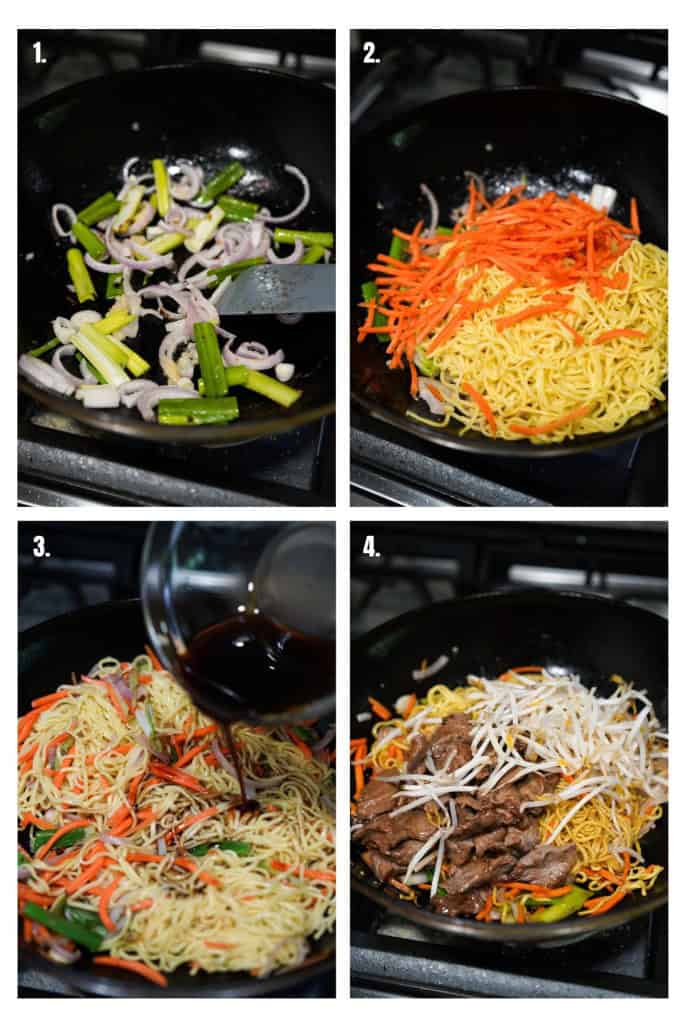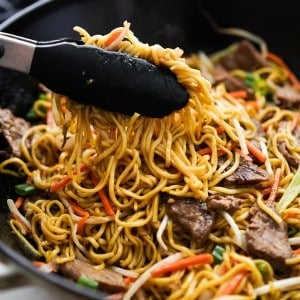Beef Chow Mein
In this classic Beef Chow Mein recipe, thin egg noodles, or chow mein noodles, are stir fried along with juicy and tender beef strips and crunchy vegetables such as carrots, green onions, and bean sprouts.
Beef Chow Mein is a classic Chinese recipe that can be found at your favorite Chinese restaurants. It is incredibly flavorful, satisfying, and easy to put together under 30 minutes!

Chow Mein with Beef
Before talking specifically about Beef chow mein, let’s take a step back and talk about what actually is chow mein.
Chow mein in Chinese simply means ‘fried noodles‘ in Chinese. However, here in North America today, the term ‘chow mein’ is typically use to describe a fried noodle dish at Chinese restaurants.
Chow mein can be found in varying styles and forms in a Chinese restaurants across the United States. It is typically made with thinner yellow or egg noodle, and with various sauces and ingredients, with or without vegetables, and with different types and cuts of meat or seafood. Like in this case, beef chow mein.
Not longer ago, I published a Vegetable Chow Mein recipe where to stir fry chow mein with various veggies for a light and quick meal. Today, we are going to make chow mein with marinated tender slices of beef sirloin, thus beef chow mein.
In my opinion, beef chow mein is a more ‘luxurious’ chow mein, as these juicy strips of beef are flavorful and tender.
We love that beef chow mein has a variety of textures from crunchy veggies, to juicy beef, to the chewy yet soft noodles. Those made for an incredible bite or mouthful each time!
Ingredients
This beef chow mein recipe is made with a few basic ingredients that are easy to find, and it truly does not require much to bring it together.

- chow main noodles – these are typically thin egg noodles that comes in a dry packaging. They are sometimes called “Hong Kong style” noodles. The noodles are usually yellow in color, hard and needs to be boiled in water to soften before stir frying.
- beef – any tender cut of beef works great! This typically calls for nicer cuts such as ribeye or sirloin. Slice them thinly against the grain so that they will be tenderness. Avoid using tough cuts as chuck roast, brisket, or stew meat.
- oyster sauce – a rich and savory sauce popular in Asian and Chinese cooking. Used to marinate the beef and also for the stir fry sauce. Has incredible umami flavors, avoid substituting. Even if you don’t like oysters, don’t be afraid of this sauce! 🙂
- shallots – can also use yellow or red onions, but shallots have a slightly more delicate and less pungent flavor, more suitable for Asian cooking.
- garlic – fresh garlic gives the best flavor, avoid using garlic powder.
- bean sprouts – mung bean sprouts work as well. These bring some nice texture to the beef chow mein dish. It doesn’t bring too much additional flavor, just exture,
- green onions – use as aromatics for some distinct and delicious flavor, so avoid substituting. Brown onions are not the same and will not produce the same taste.
- carrots – shredded thinly. I like to buy matchstick carrots to make it easier!
- sesame oil – used to make the sauce – it has a distinct nutty flavor
- low sodium soy sauce – I used low sodium soy sauce for this recipe so if you are using regular soy sauce you may want to reduce it slightly just in case it may be too tasty.
- rice wine cooking wine – I typically use the classic Shao Xing Rice Wine which is a staple in Chinese cooking.
- granulated sugar – an important ingredient to achieve that perfect balance (between sweet and savory).
How to make it
Step 1: Marinate beef
I start with this so that beef can be set aside while we prepare the rest of the items. Beef doesn’t need to be marinated for long, just 10 minutes or so is fine.
Soak beef in a simple and tasty marinade consisting of oyster sauce and corn starch for a few minutes. This will give some nice flavors to the beef. Because we are slicing the beef in thin slices, we just need to marinate it briefly.
Step 2: Boil noodles in hot water
You will want to follow the package instructions to soften noodles, but most likely, you’ll need to boil for a few minutes in hot water, then remove from heat promptly once noodles are done boiling.
Run noodles through cold water or toss them in oil so that they do not stick to each other.

Step 3: Make sauce for noodles
Mix all of the sauce ingredients in a bowl – oyster sauce, low-sodium soy sauce, sesame oil, rice cooking wine, and granulated sugar.

Step 4: Prepare ingredients
Prepare the rest of the ingredients (washing, chopping, slicing etc) and have them ready to go before you start stir frying.
Step 5: Saute Beef
Using a large skillet or wok, heat it on high heat and let the pan get very hot.
Once the wok is hot, drizzle with oil and sear the sirloin strips. Flip beef after 15-20 seconds, or when it turned golden brown. Let it cook for another 30-60 seconds, stirring occasionally. Avoid overcooking so that beef remains tender and juicy. Once beef is no longer pink-ish, remove from wok promptly.
This should be a quick process if the pan is hot and shouldn’t take more than a few minutes. If beef is cooked for too long, it will be tough and no longer juicy.

Step 5: Sauce Noodles and Vegetables
Heat wok with more vegetable oil, then saute garlic, green onions and shallots until fragrant.
Add carrots and chow mein noodles – toss to combine everything.
Add sauce, toss to combine, and then add bean sprouts.
Bring beef back into the chow mein dish, toss to combine one last time. We are going for perfectly combined moist noodles and beef, with crunchy vegetables in every bite.

Once beef chow mein is done, promptly remove from heat to avoid overcooking.
Similar to when we were cooking the beef, this part of the process should go really quickly as well. It shouldn’t take more than a couple of minutes from start to finish since we are cooking this in hot heat.
When cooked for too long, noodles and veggies will become mushy and unappetizing.
Beef chow mein is best served warm and hot off the stove! Enjoy the lovely chewy chow mein noodles, crunchy textures of bean sprouts and carrots, along side that tender juicy perfectly seasoned beef strips.
This one-pan beef chow mein dish should take no more than 30 minutes to make from start to finish, and it is definitely tastier (much better, more complicated flavors) than your average Chinese takeout, and is much healthier too!

Storage and Reheating Instructions
If beef chow mein is made ahead or if there are leftovers, store beef, noodles and vegetables in an airtight container in the refrigerator for up to 5 days.
When ready to eat, drizzle a few drop of water onto chow mein and reheat in the microwave. Toss half way through and continue reheating until chow mein is completely heated.
Tips and Tricks
Here are a couple of things to take note to ensure success when making beef chow mein:
- Preparing the ingredients – Be sure to have all your ingredients prepped and ready before you start cooking. Chop all your vegetables, marinate the beef, sauce prepared – it all contributes to a faster and smoother cooking experience. The stir fry process goes fast!
- Choose the right cut of beef – For the best Beef Chow Mein, choose a tender cut of beef such as sirloin or tenderloin. Slice your beef cross grain so that it’ll be even more tender.
- Keep the noodles separate – Toss your boiled noodles with a little oil to prevent sticking, or rinse them in cold water.
- Use a large pan or wok – A large pan or wok will allow the food to cook evenly and prevent it from becoming soggy from being piled too close together.
- Cook on high heat – use appliances that can withstand high heat and crank your burner up as high as you can. Beef chow mein cooks best on high heat. Ingredients will lose its textures if it’s not cooked on high heat.
Frequently Asked Questions
Although a wok is ideal for stir-frying due to its shape, a large skillet or frying pan with high sides that can withstand high heat will also work very well.
Thin egg noodles, ‘chow mein noodles’, or “Hong Kong” style are the best.
Other veggies I like to use are bell peppers, cabbage, carrots, onions, snow peas, and bok choy. If you add a lot more veggies, you may want to make more sauce to go with it.
Check out my Vegetable Chow Mein recipe!
Yes! Add red pepper flakes, chili oil or sriracha into the sauce mixture.

DID YOU ENJOY THIS RECIPE? Please comment below and give us a 5-star rating! This will help others find this recipe on Google and Pinterest. We very much appreciate your help! 🤍
More Noodle Recipes
- Rice Noodle with Peanut Sauce
- Udon Noodle Stir Fry
- Mongolian Beef Noodles
- Instant Pot Chicken Ramen
- Garlic Noodles with Shrimp
- Pad Thai Noodles
- Pad See Ew Noodles

Beef Chow Mein
Ingredients
- 6 oz chow mein noodles
- ½ lb sirloin beef sliced cross grain
- 1 tbsp oyster sauce
- ½ tsp corn starch
- ½ shallot sliced
- 2 cloves garlic minced
- ½ cup green onions sliced
- 1 cup bean sprouts
- 1 cup carrots shredded
Sauce
- 2 tbsp oyster sauce
- 1 tbsp low sodium soy sauce
- 1 tbsp sesame oil
- 1 tbsp rice cooking wine
- 1 tsp sugar
Instructions
- Toss sirloin with 1 tbsp oyster sauce and corn starch. Set aside.
- Cook chow mein noodles according to package directions – most likely it'll require boiling in water for a few minutes, then drain access water.
- Mix all of the sauce ingredients in a bowl. Set aside.
- Prep all of the remaining ingredients and have them ready to go.
- Set a wok over high heat. Let it get very hot.
- Once the wok is ready drizzle with a little oil and sear the sirloin. Flip after 15-20 seconds, or when beef is golden brown on the bottom. Let it cook for another 30-60 seconds. Avoid overcooking. Once beef is no longer pink-ish, remove from wok promptly. Set aside.
- Add shallots, garlic, and green onions to the wok. Stir until fragrant.
- Add cooked chow mein noodles and carrots. Stir for a few minutes.
- Add sauce. Keep stirring.
- Add bean sprouts.
- Add seared sirloin. Stir to incorporate beef. Once everything is combine, remove from heat immediately. Avoid overcooking.
- Serve and enjoy!










I was craving beef chow mein and landed on this amazing recipe! Our whole family loved it and I’ll be making this sone regularly.
Thank you Jules! So glad your family loved the recipe.